![]() 1st Battalion 22nd Infantry
1st Battalion 22nd Infantry ![]()
Duty in Goldfield, Nevada 1907-1908
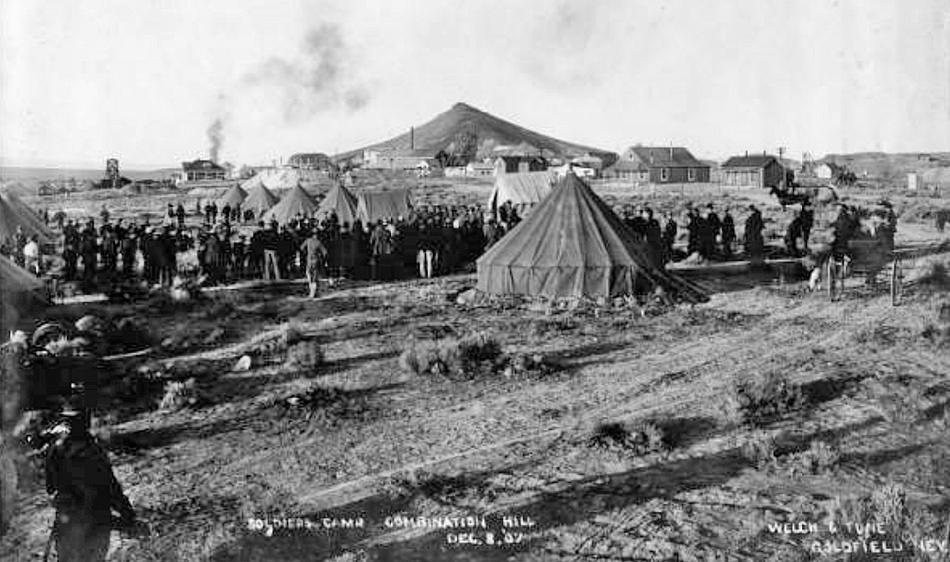
Part of the camp of the
22nd Infantry at Goldfield, Nevada December 8, 1907.
Located just outside the town in an area known as
"Combination Hill".
Photo from the University of Nevada, Las Vegas Libraries
Gold was discovered in 1902 at a
site in Nevada which became the town of Goldfield.
The boomtown expanded rapidly, until, in 1906, with a population
of 20,000, it became
the largest town in the State. Wages and working conditions at
the mines strained relations
between the owners and the labor unions, resulting in a strike by
workers in 1906, which only
increased tension between the two, and the situation grew worse,
until, at the end of 1907,
Governor John Sparks asked President Teddy Roosevelt to send
Federal troops
to maintain order and prevent an outbreak of violence.
Many believed the request for
troops was done out of sympathy for the mine owners, in order to
give them the means
to control their workers, but the fear of violence and breakdown
of civil order was not unfounded.
Similar strikes in the latter part of the 19th Century, at the
mines at Wilkes-Barre, Pennsylvania, Cripple Creek,
Colorado, and the Coeur d'Alene region in Michigan, had resulted
in violence by both sides, riots, injuries and death.
Normally the individual States
would deal with such situations by calling out their State
Militia, National Guard
or State Police forces to preserve order. Nevada, however, had
none of those organizations. A declining economy in Nevada
had prevented its State Militia from gaining accreditation enough
to become absorbed into the Federal National Guard system,
with the loss of Federal funds to help maintain its existence.
Therefore, in 1906 Governor John Sparks disbanded
the Nevada State Militia, and since Nevada had no State Police
organization, when impending trouble became the cause for
alarm in Goldfield, there was no existing body to send to the
town to ensure order would prevail.
In early December 1907, Sparks
began appealing to Roosevelt for aid, and on December 5, 1907 he
formally and officially
requested that Federal Troops be sent to Goldfield. Roosevelt
directed the Army's Division of the Pacific to send
enough forces to the town to maintain order. In turn, General
Frederick Funston, Commander of the garrison at the Presidio,
Monterey, California, was ordered to dispatch troops under his
Command to perform this duty.
Funston had at his disposal
nearly 2,000 troops he could mobilize, if necessary, including
the 22nd Infantry, the 20th Infantry,
the 14th Cavalry, and three batteries of the 1st Field Artillery.
He chose the 22nd Infantry to be the advance party,
with the hope that a single regiment would suffice.
On December 4 the 22nd Infantry
was alerted to be ready to go to Goldfield. Elements of the 22nd
Infantry, led by
its Commander, Colonel Alfred Reynolds, left California by train
early in the morning on December 6, and arrived in Goldfield
the same day. The first contingent, consisting of Companies B, D,
K, I and M, detrained in Goldifield at about noon,
and the second contingent, consisting of Companies C, E, F, G and
H, arrived just before midnight. Companies A and L
were left behind in California to guard the post there.
Approximately 400 Soldiers of the 22nd initially went to
Goldfield.
Later Company A would change places with Company H, and then, at
some time, Company H would return to Goldfield.
Colonel Reynolds found no unrest
in Goldfield, and communicated such to the President. By the
middle of December,
Roosevelt realized that Sparks had exaggerated his claims of a
violent atmosphere, and ordered the Regiment
to return to California. However, he worried that without some
unit of the Army remaining there, the situation
could still deteriorate, and he re-directed Reynolds to continue
to establish a presence in the town. Accordingly,
on January 3, 1908, most of the 22nd Infantry returned to their
duty stations in California. Companies H and I
were left in Goldfield, along with the machine gun platoon,
altogether about 150 Soldiers.
Roosevelt further demanded that
the State of Nevada immediately create a militia or State police
force,
in order to deal with such situations. The Nevada State
Legislature was brought together in a special session,
and a State Police force was created. By March 7, 1908, all
elements of the 22nd Infantry had returned to their
normal duty stations in California.
The following newspaper articles
illustrate the episode. This is not an in depth study of the
Goldfield
labor and owner relations in the mining industry. Articles
presented here were chosen for their relevance
to the part the 22nd Infantry played in the events.
|
Tonopah Daily Bonanza Thursday, December 5, 1907 December 5 was the day The headline of this Nevada
newspaper One of the bylines mentions
that General Funston Actually Funston had over two
thousand men The Regiment would leave the
next day, Photo from the Nevada Appeal website |
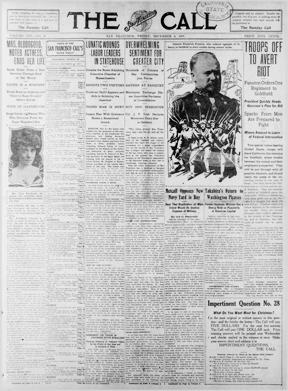
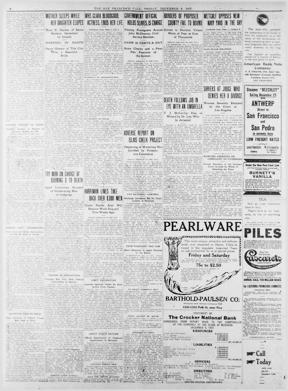
The San
Francisco Call, Friday, December 6, 1907
The day the 22nd Infantry would leave by train for Goldfield. The
front page had a photo of Brigadier General Frederick Funston,
Commander of the garrison at the Presidio, complete with his
Medal of Honor. Below Funston's portrait was a stylized
representation
of US troops, of the kind seen during the years of the Spanish
American War up to WW1.
CDNC California Digital Newspaper Collection
|
|
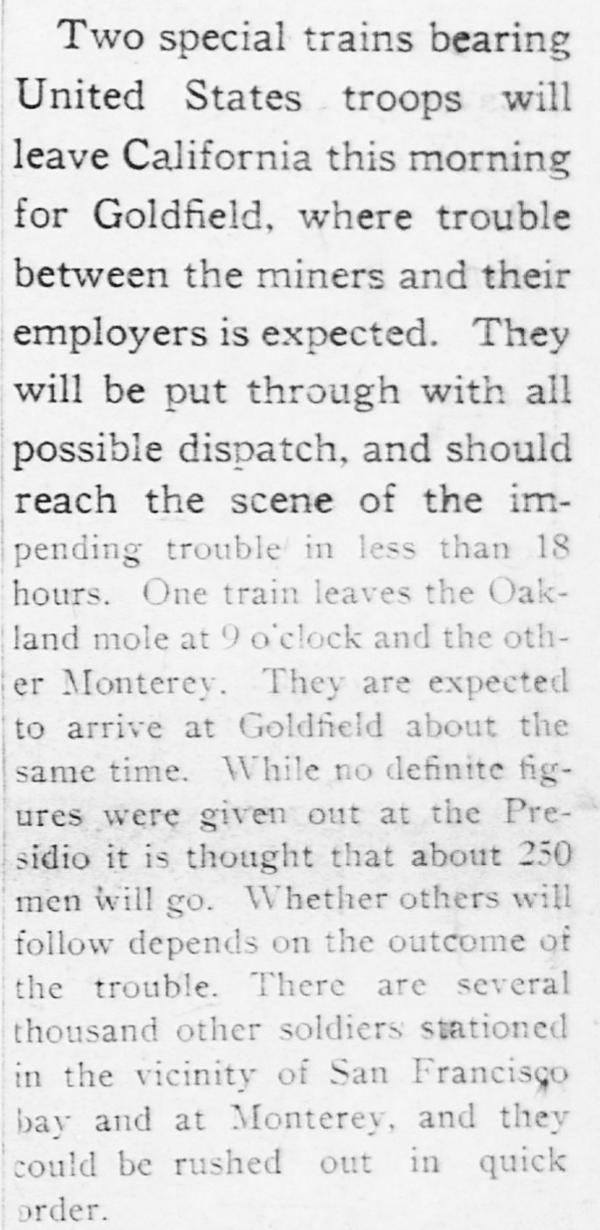
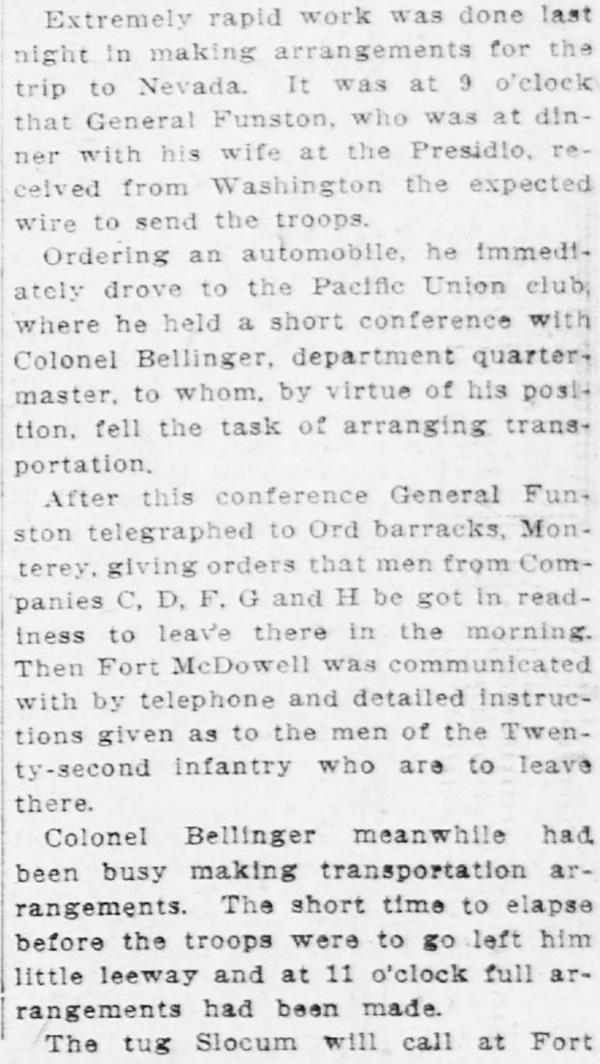
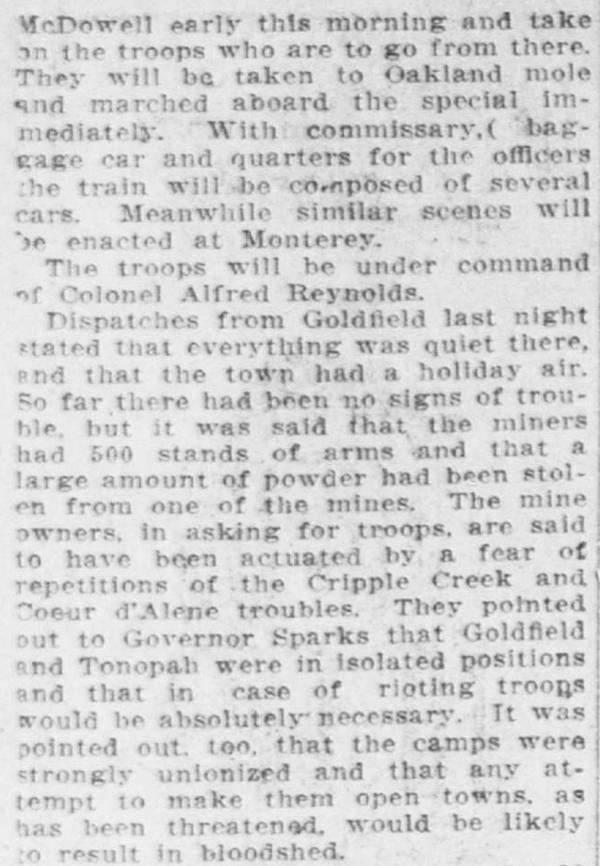
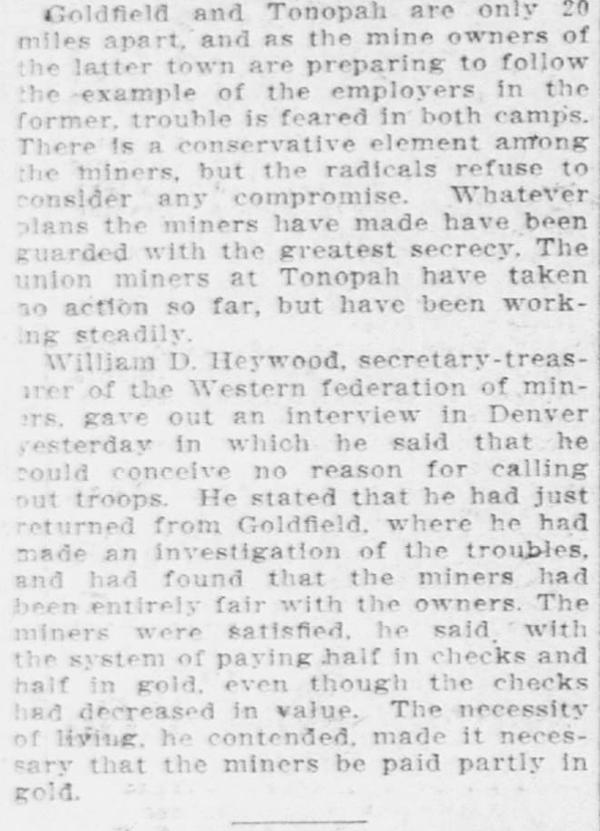
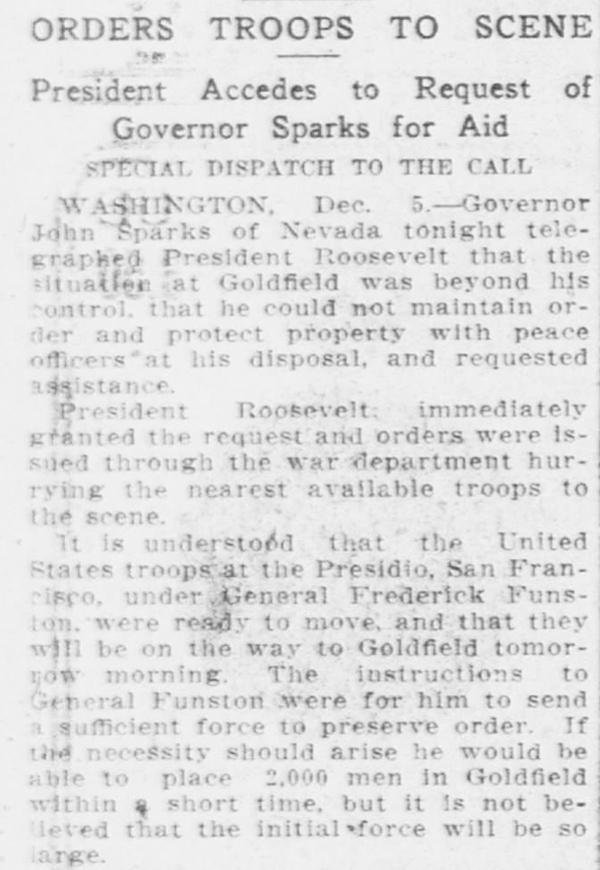
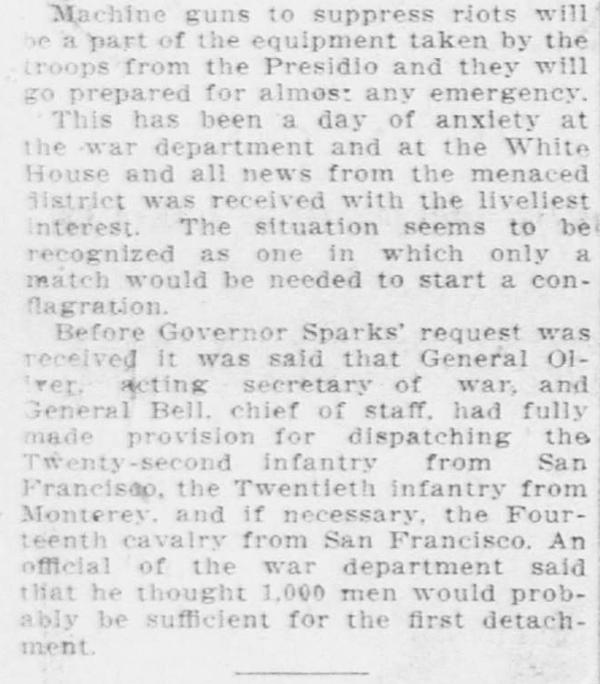
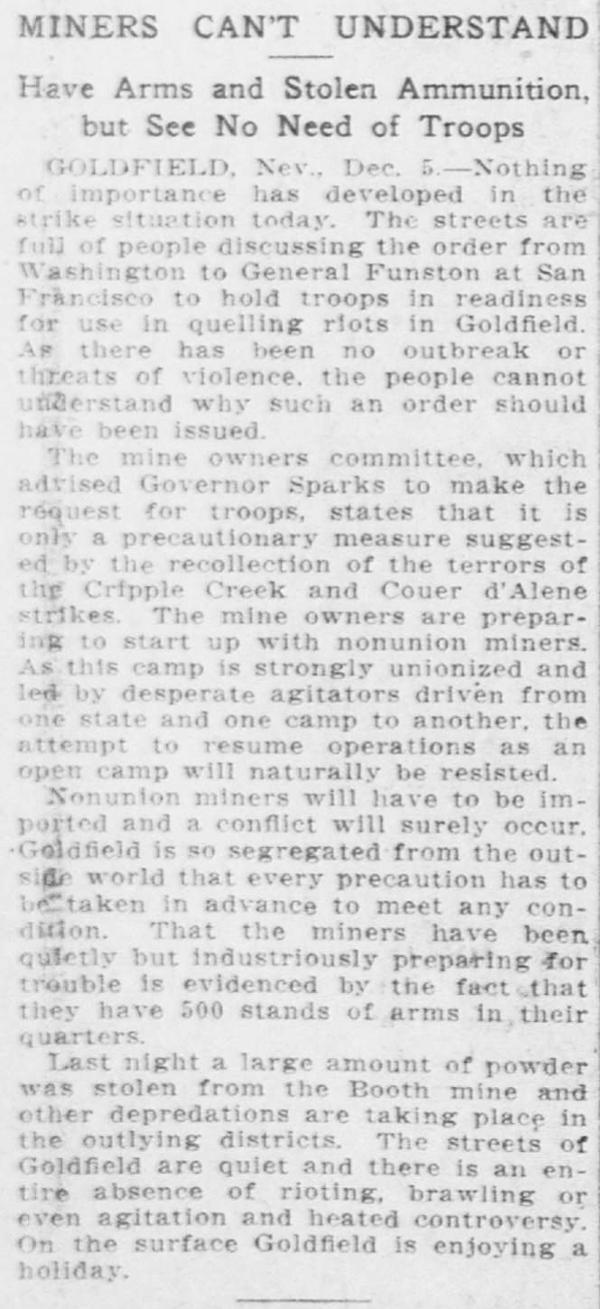
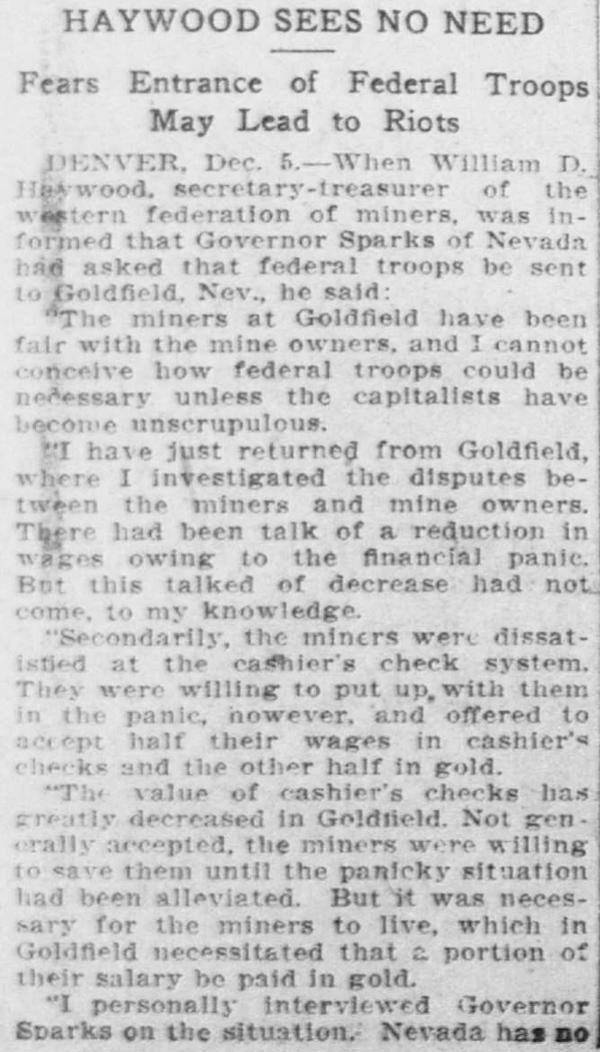
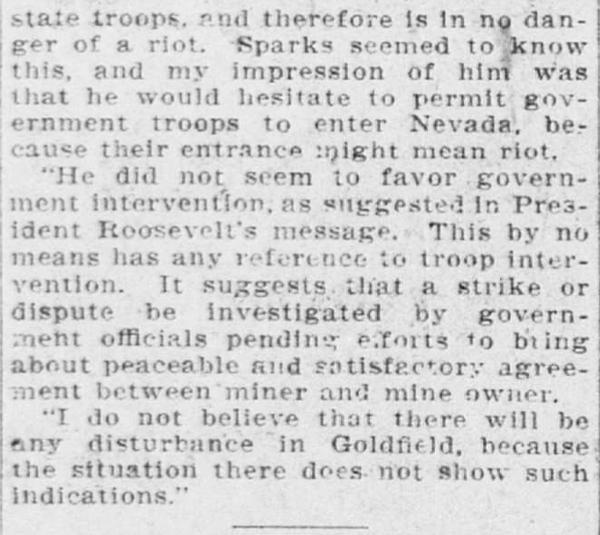
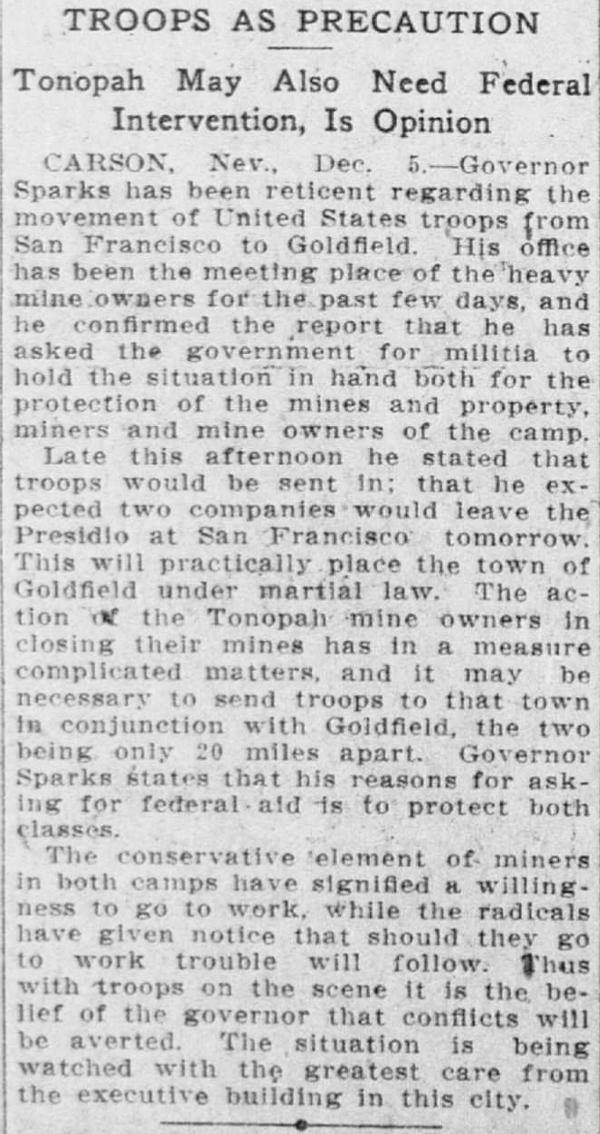
Above article from the San Francisco Call, Friday, December 6, 1907
CDNC California Digital Newspaper Collection
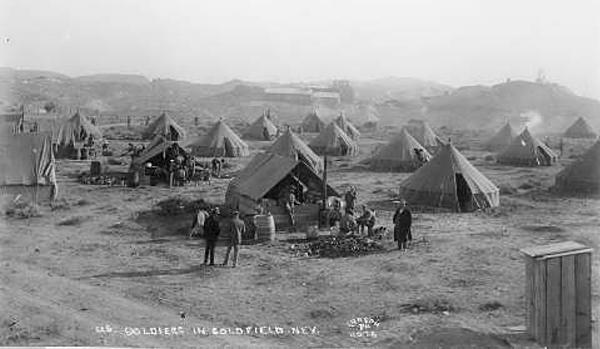
Part of the 22nd Infantry encampment at Goldfield
Photo from the Pinterest website
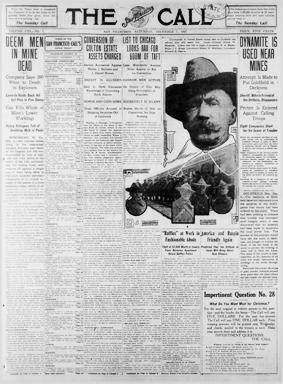
The San
Francisco Call, Saturday, December 7, 1907
The front page had a photo of Colonel Alfred Reynolds, Commander
of the 22nd Infantry, above a photo of 22nd Infantry Soldiers
and the train which carried them to Goldfield. Superimposed at
the bottom were the portraits of four officers from the 22nd
Infantry.
CDNC California Digital Newspaper Collection
-------------------------------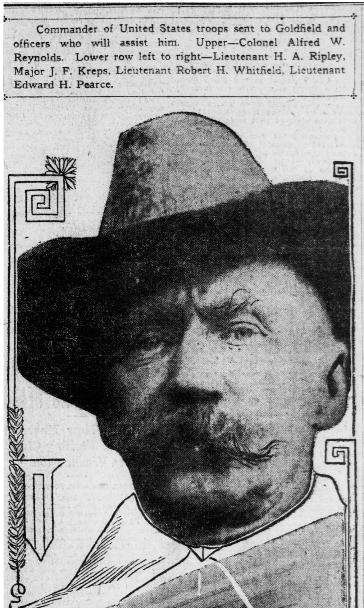
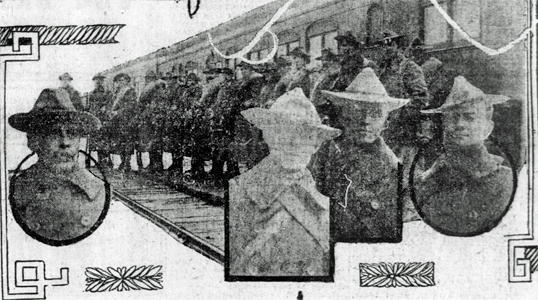
Website Ed., Top of the photo is
Colonel Alfred Reynolds, Commander of the 22nd Infantry.
The four officers in the bottom of the photo, left to right were:
1st Lieutenant Henry Ripley - served
with the 22nd Infantry 1899-1909
Major Jacob Kreps - served with the 22nd Infantry 1883-1914
1st Lieutenant Robert Whitfield - served with the 22nd Infantry
1899-1917
2nd Lieutenant Edward Pearce - served with the 22nd Infantry
1906-1909
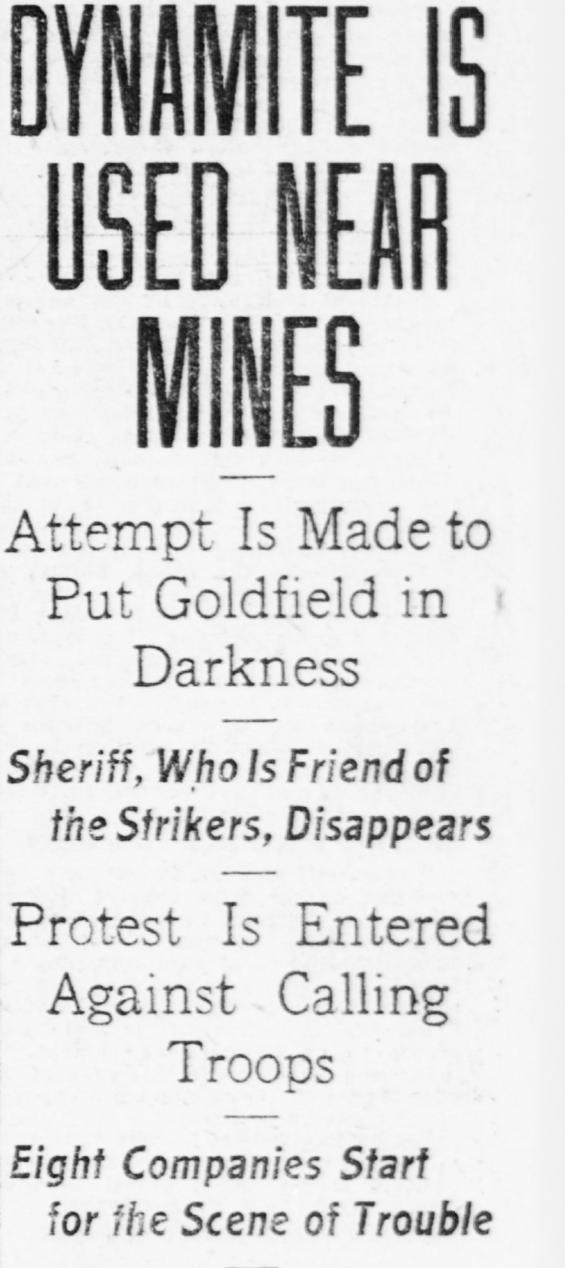
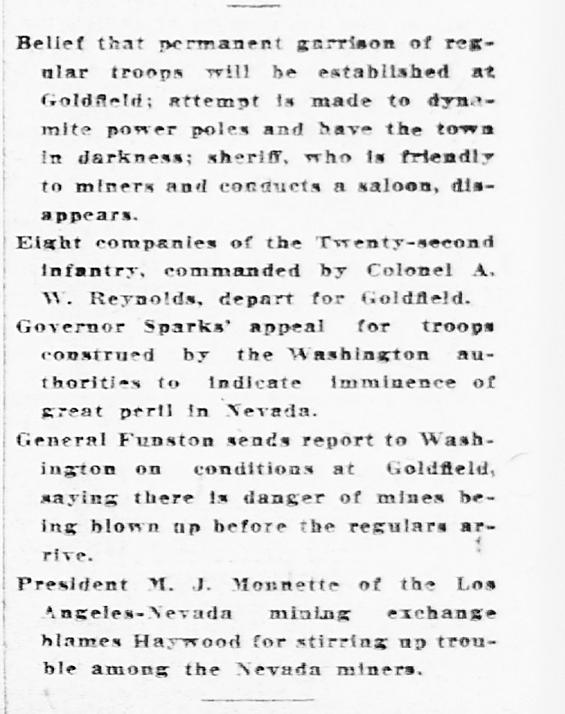
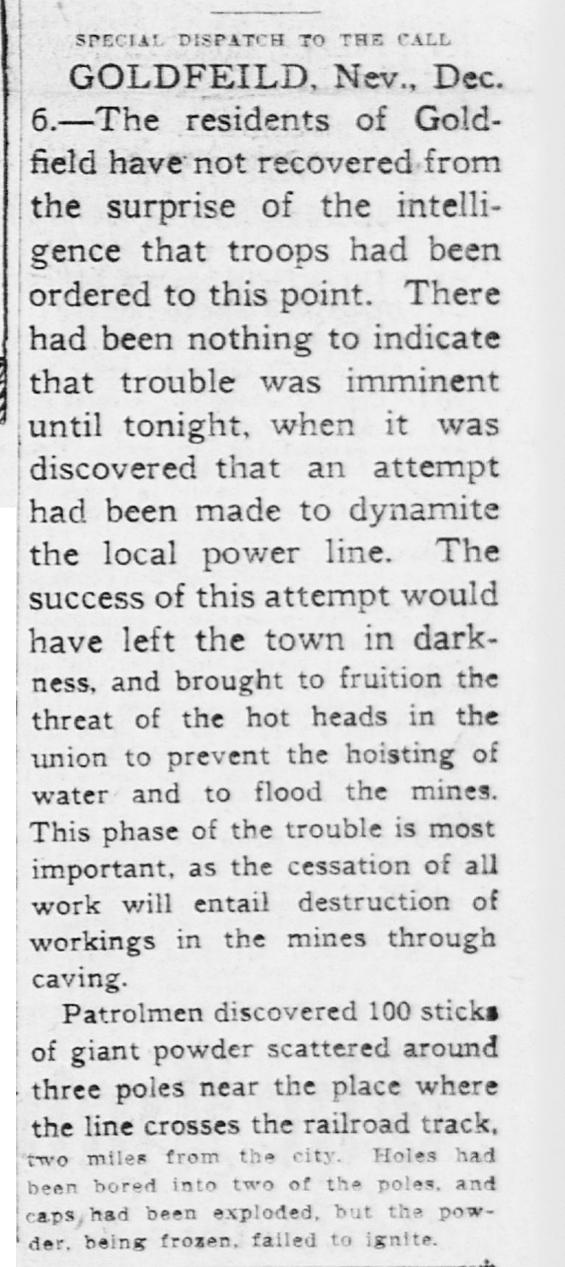
Above article from the San Francisco Call, Saturday, December 7, 1907
CDNC California Digital Newspaper Collection
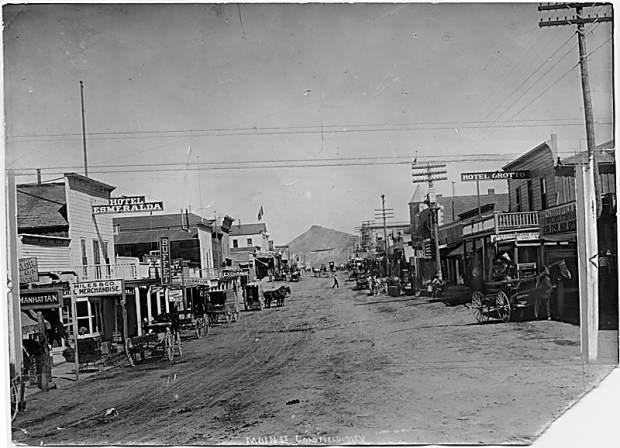
The main street in
Goldfield. From the Tonopah Daily Bonanza
, Thursday December 5, 1907.
Compare this photo with the one in the article below.
Photo from the Nevada Appeal website
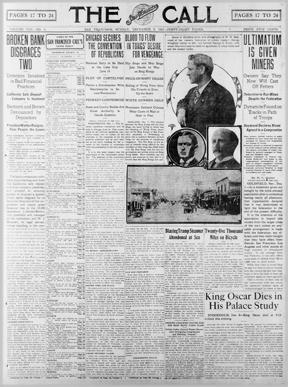
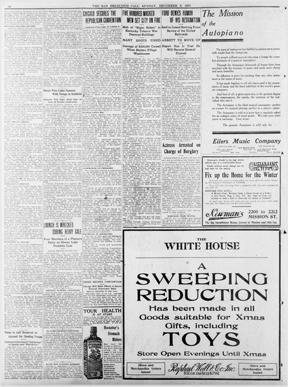
The San
Francisco Call, Sunday December 8, 1907
The front page had a photo of William Haywood, the socialist
leader of the Industrial Workers of the World, which had split
off
from the Western Federation of Miners. Below his photo were
photos of George Wingfield and Senator George Nixon, who were
co-owners of the Goldfield Consolidated Mines Company. Underneath
them was a photo of the main street in Goldfield.
CDNC California Digital Newspaper Collection
-------------------------------------------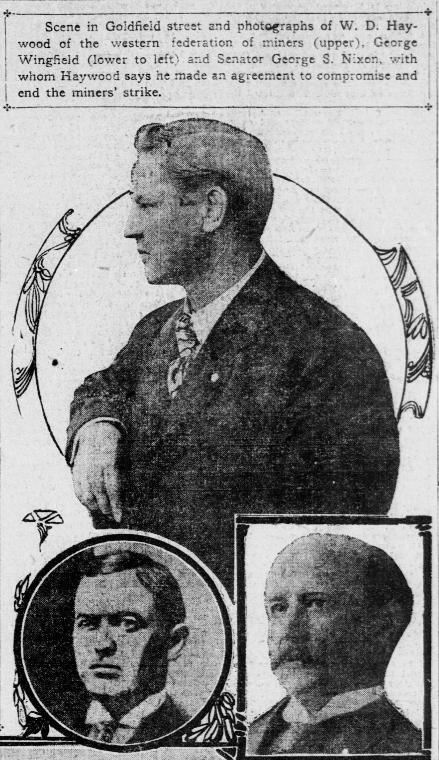
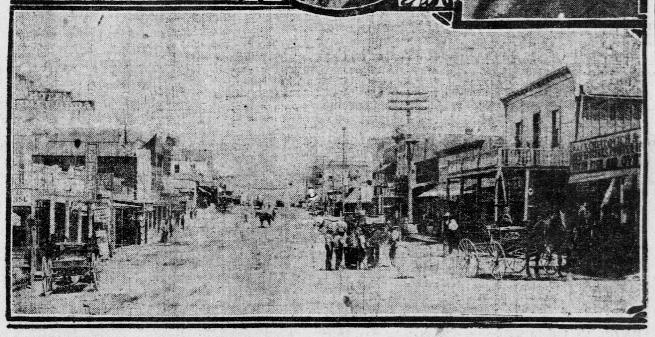
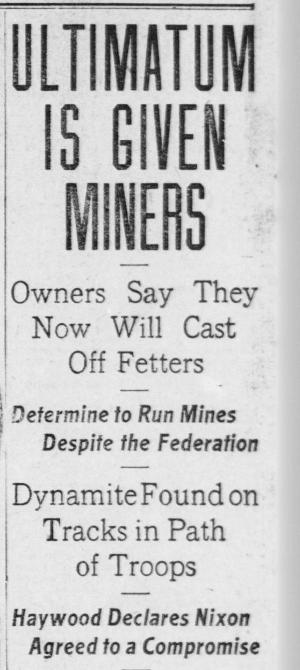
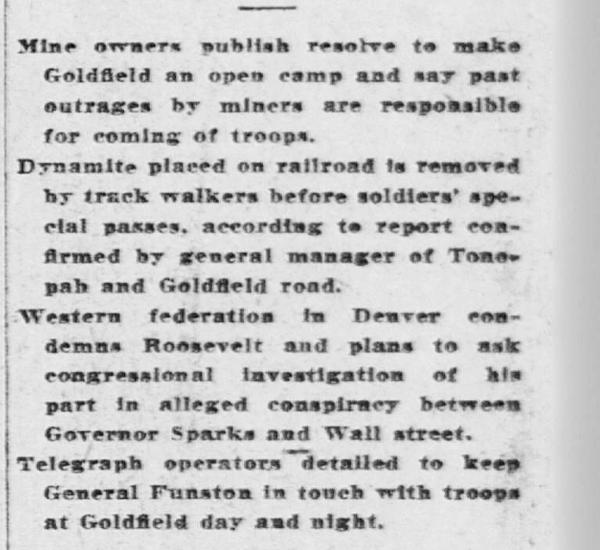
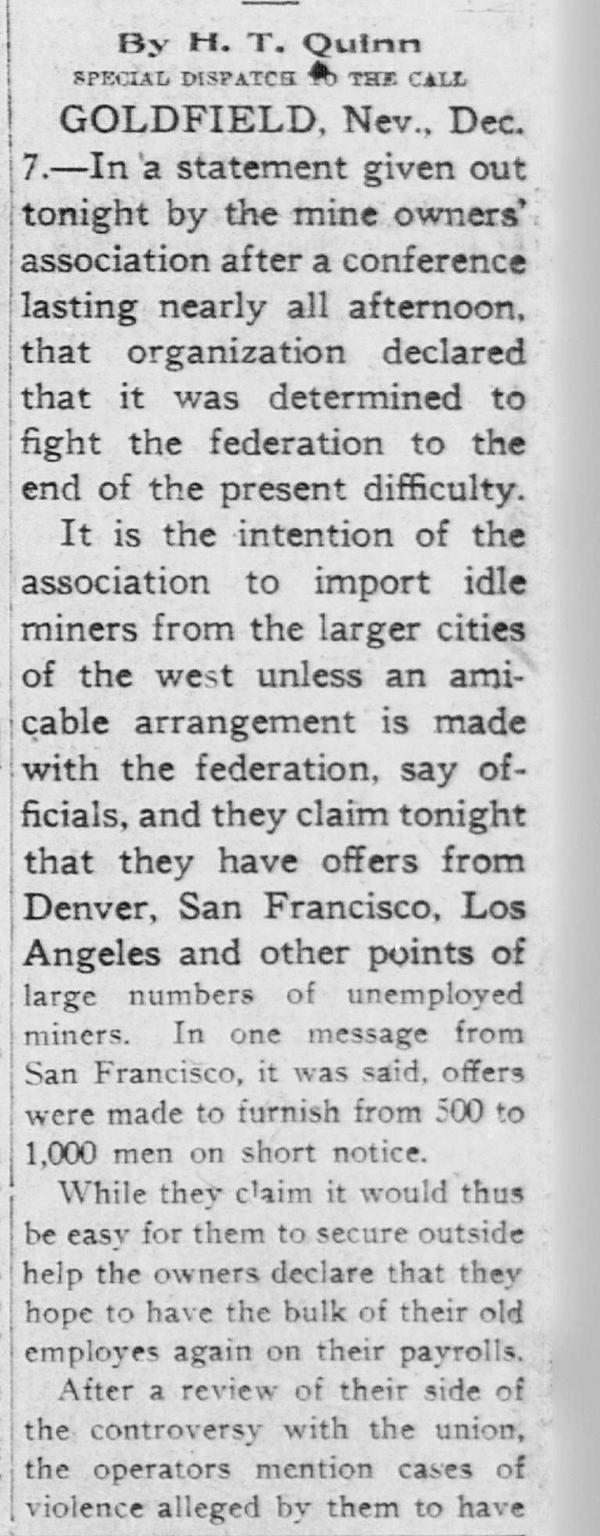
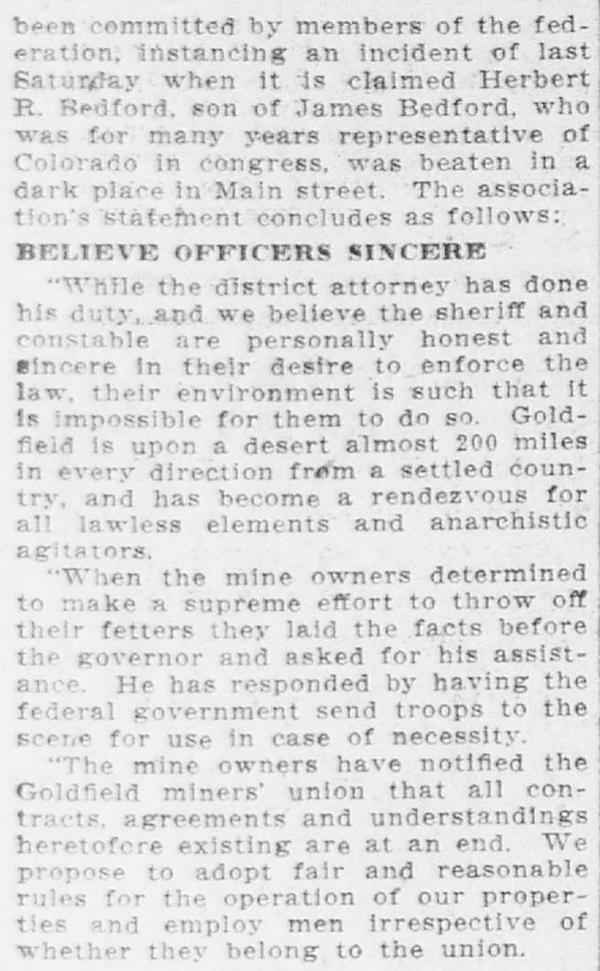
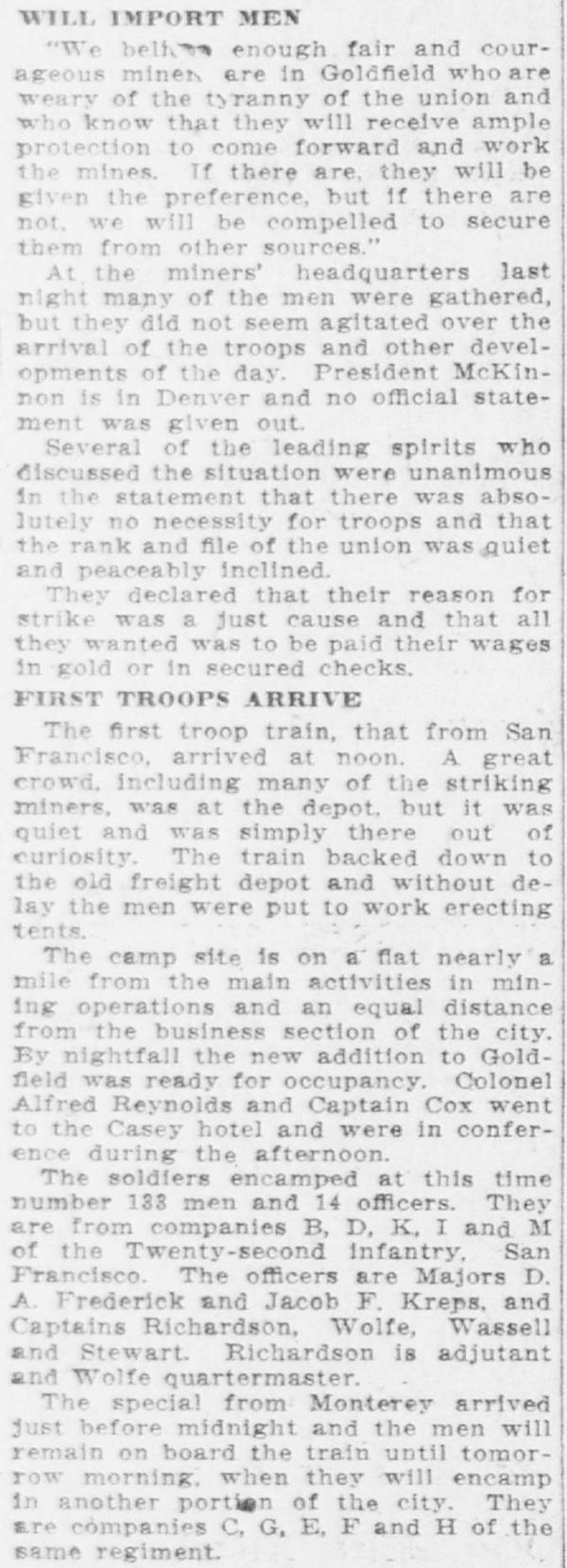
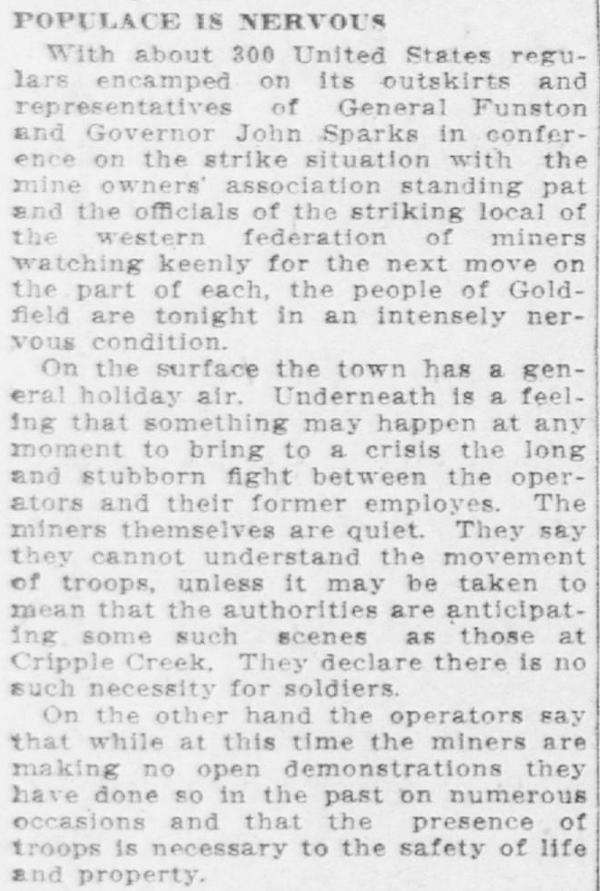
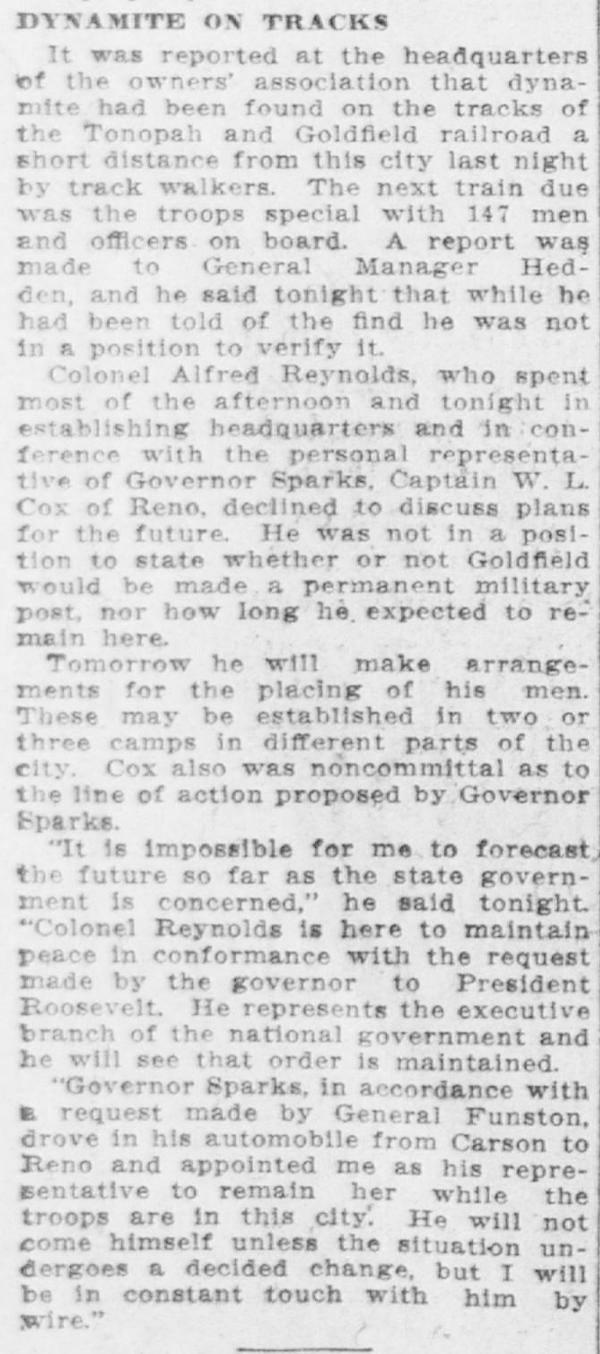
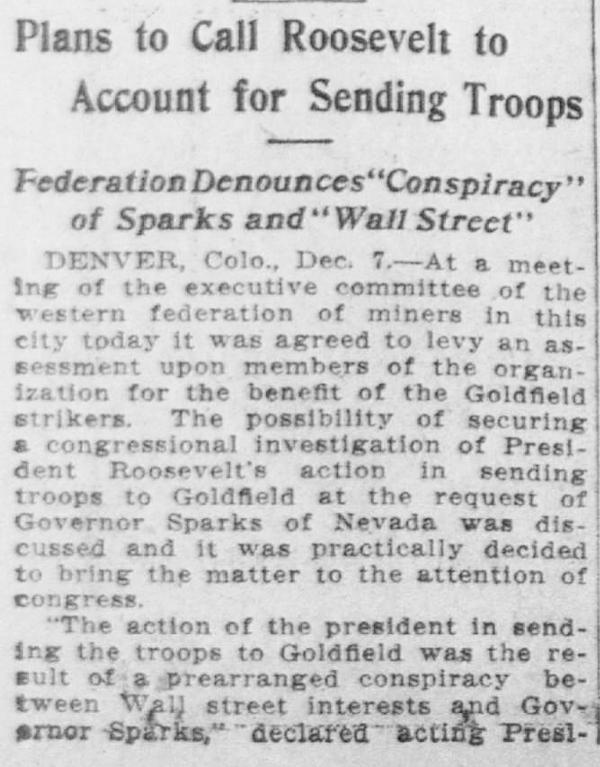
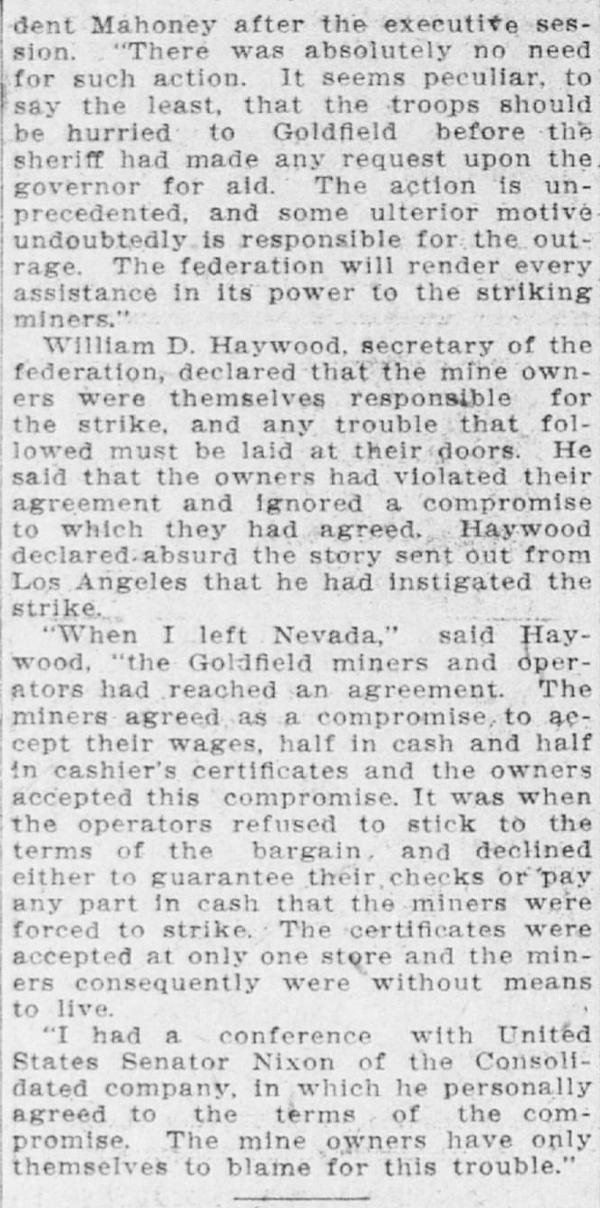
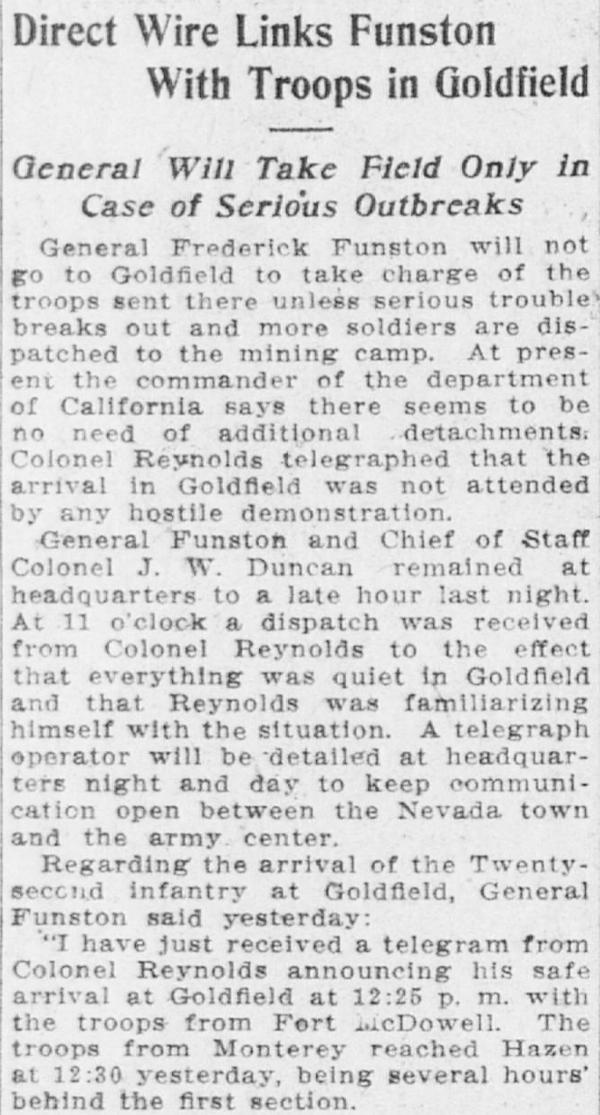
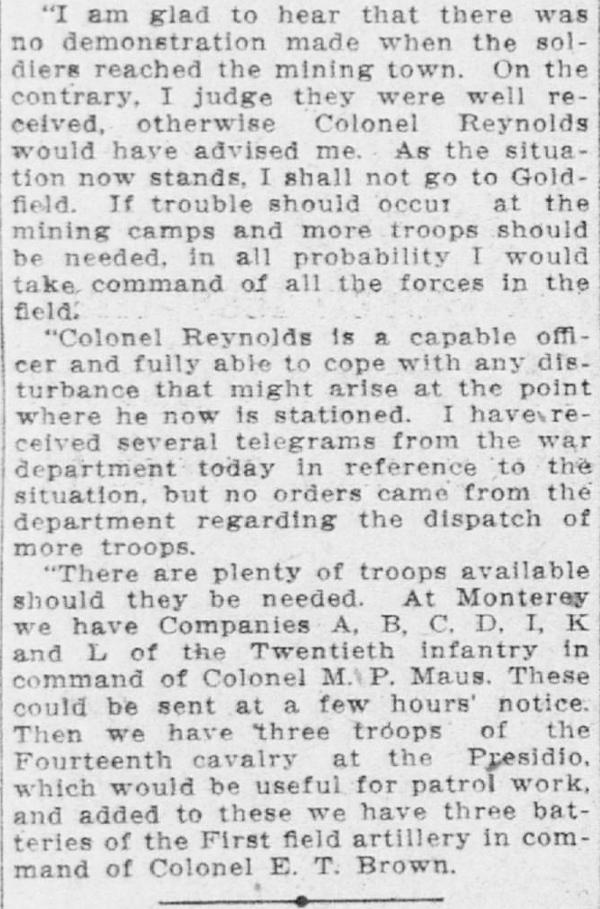
Above article from the San Francisco Call, Sunday, December 8, 1907
CDNC California Digital Newspaper Collection
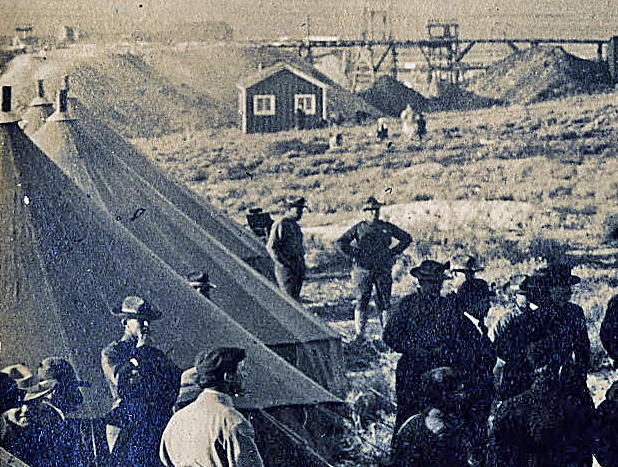
22nd Infantry Soldiers at their camp at
Goldfield, with civilians milling around. One of the mines can be
seen
in the background. December 8, 1907.
Photo from the University of Nevada, Las Vegas Libraries
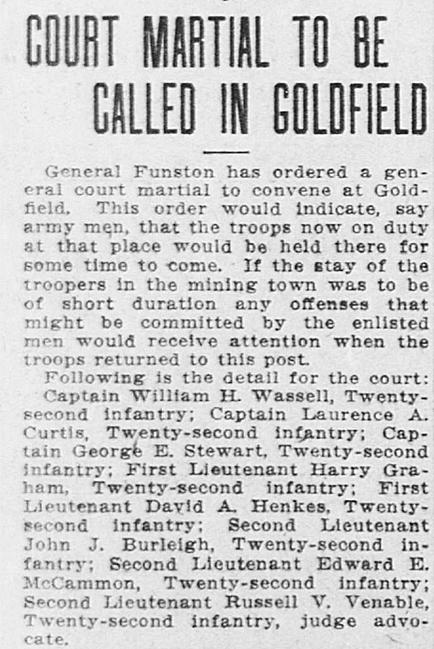
The above article is from the San
Francisco Call, Thursday, December 19,
1907.
Amid speculation that the troops would be recalled, the article
points out that a court martial board
convened by the 22nd Infantry indicated the troops planned to
stay in Goldfield for a while.
CDNC California Digital Newspaper Collection
By December 21, 1907, President
Roosevelt, feeling that the situation in Goldfield had never
warranted
sending in troops, and that he had been suckered into doing so by
the Governor of Nevada, issued orders
for the removal of the 22nd Infantry from the town.
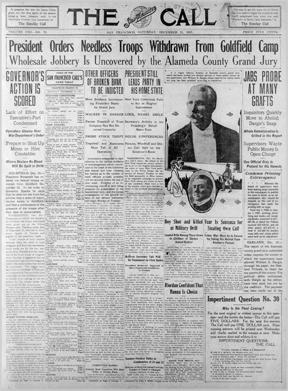
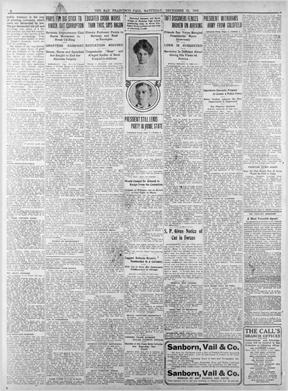
The San
Francisco Call, Saturday, December 21, 1907
The headline illustrated Roosevelt's frustration, and his
decision to withdraw the troops.
CDNC California Digital Newspaper Collection

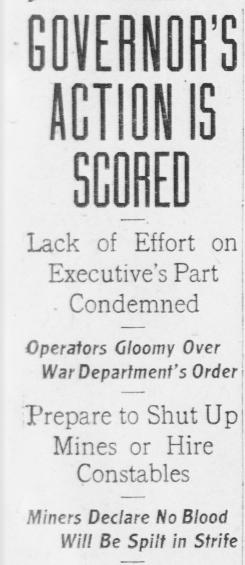
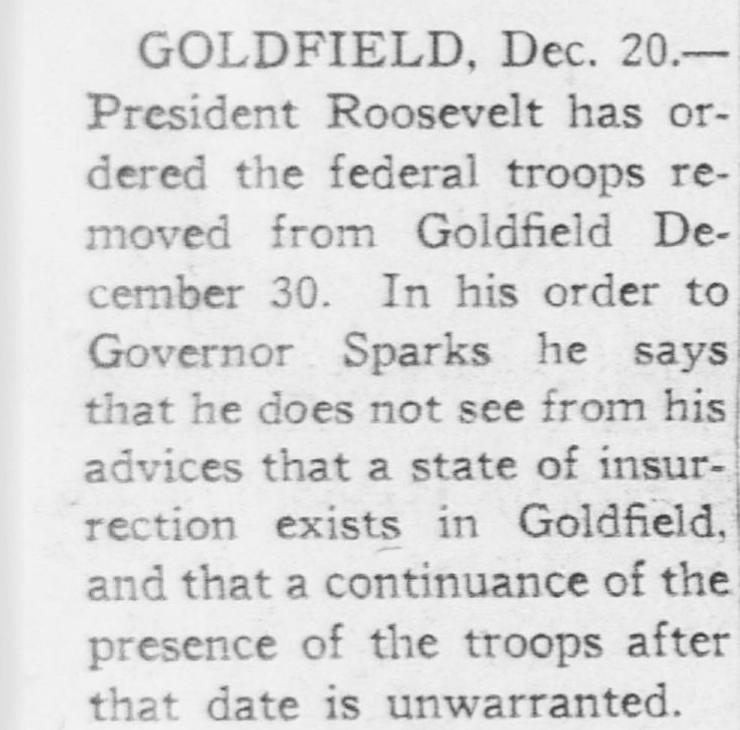
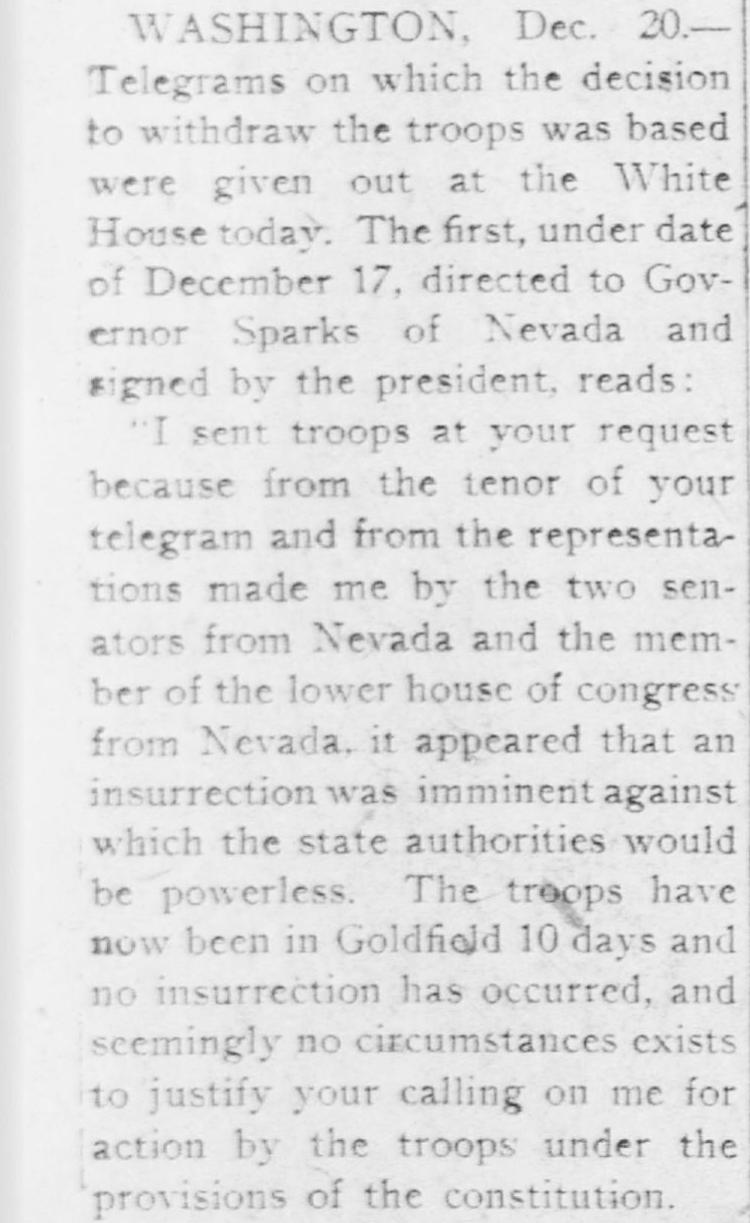
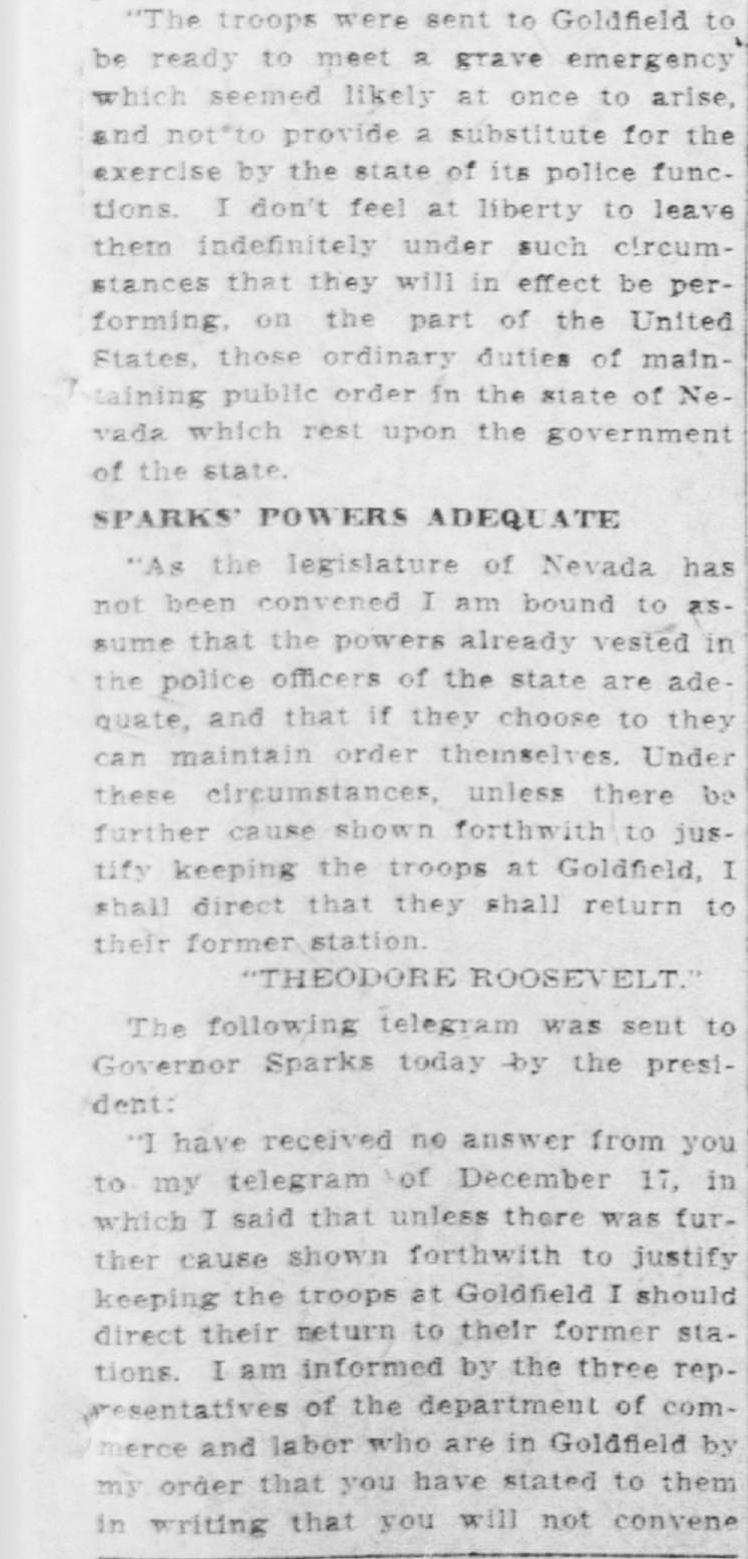
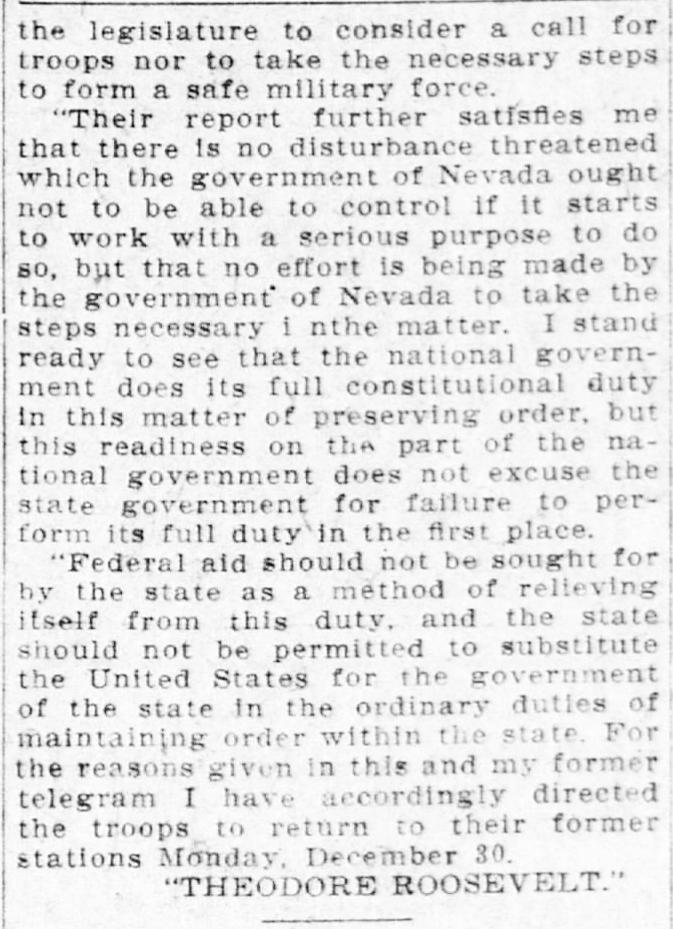
The San Francisco Call, Saturday, December 21, 1907
CDNC California Digital Newspaper Collection
On December 28, 1907, Roosevelt
rescinded the order to withdraw the 22nd Infantry from Goldfield,
out of concern that their presence in the town may have
aggravated the situation, and that their withdrawl
would leave no policing body to deal with possible repercussions.
He decided to let the troops remain
at the town temporarily, on the condition that the Governor of
Nevada call a special session of the
State Legislature, for the purpose of establishing some kind of
policing force to deal with situations
such as that which had arisen in Goldfield.
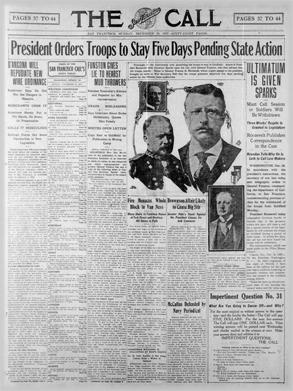
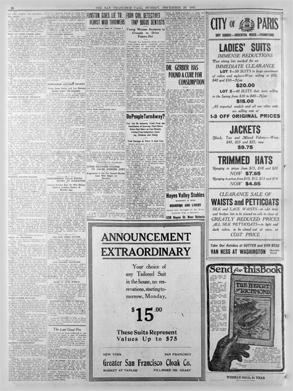
The San
Francisco Call, Sunday, December 29, 1907.
The article was accompanied by photos of some of the principal
participants at that time,
President Roosevelt, flanked by Governor Sparks, General Funston,
and Senator Francis Newlands
of Nevada. Sparks had enlisted Newlands in his appeal to
Roosevelt to let the troops remain at Goldfield.
CDNC California Digital Newspaper Collection

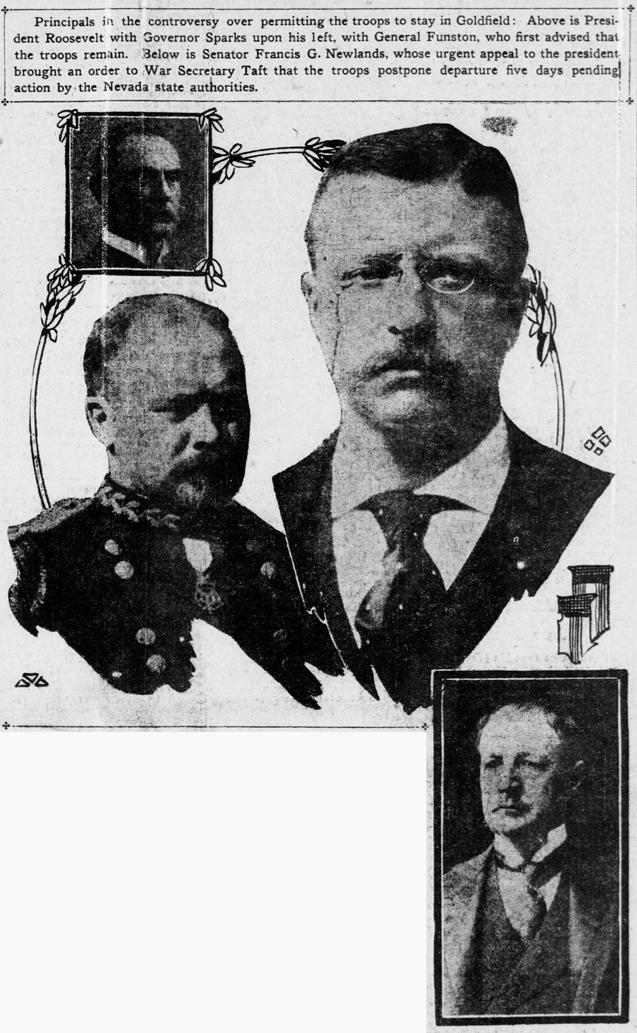
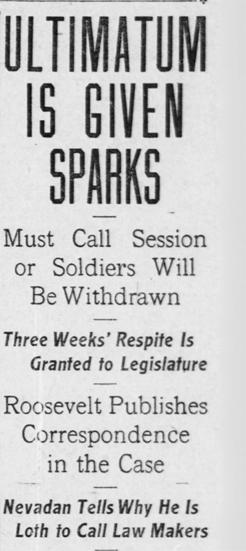
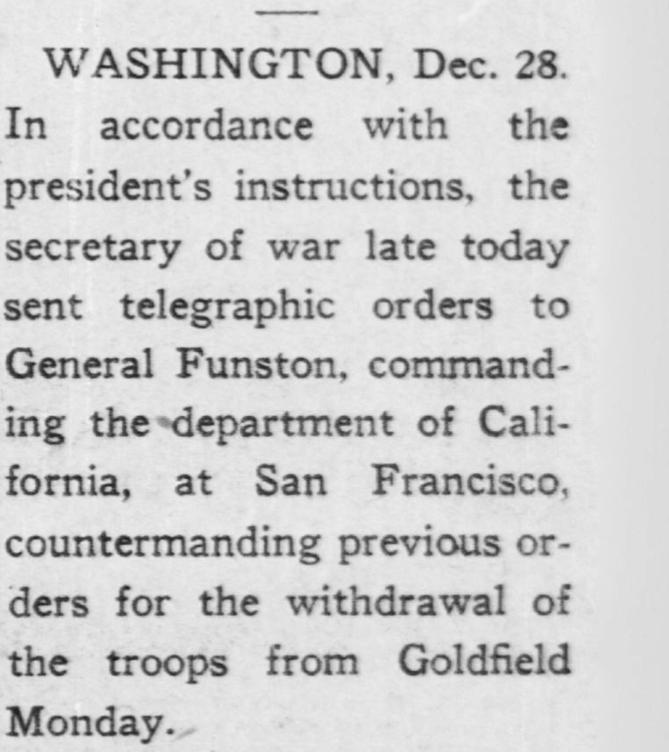
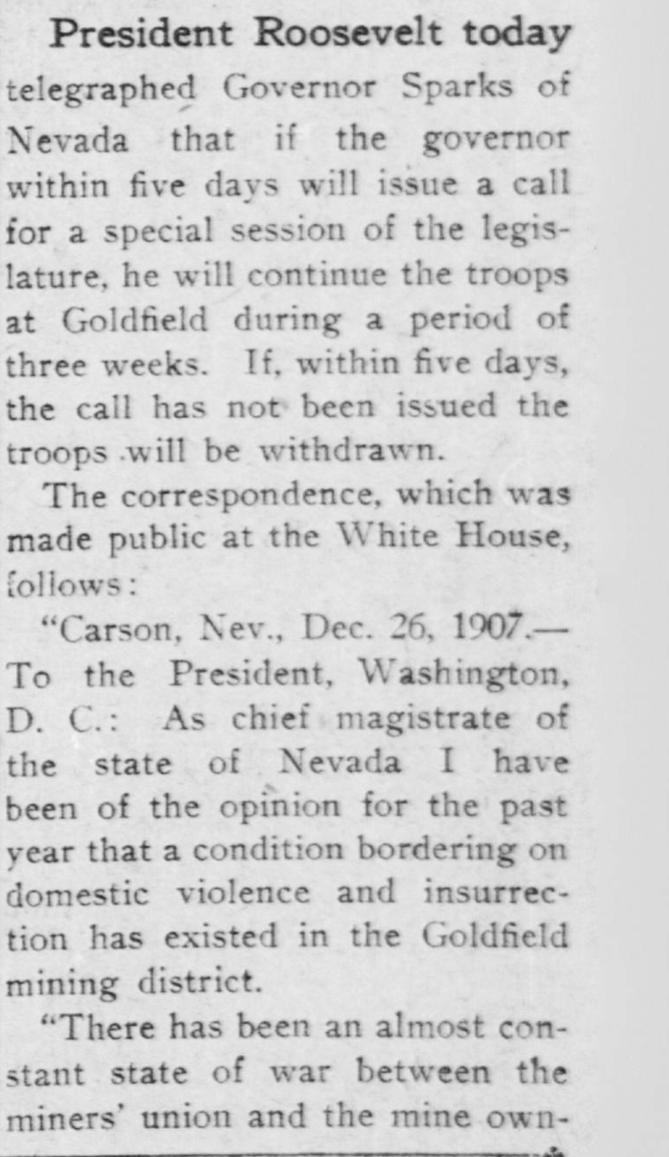
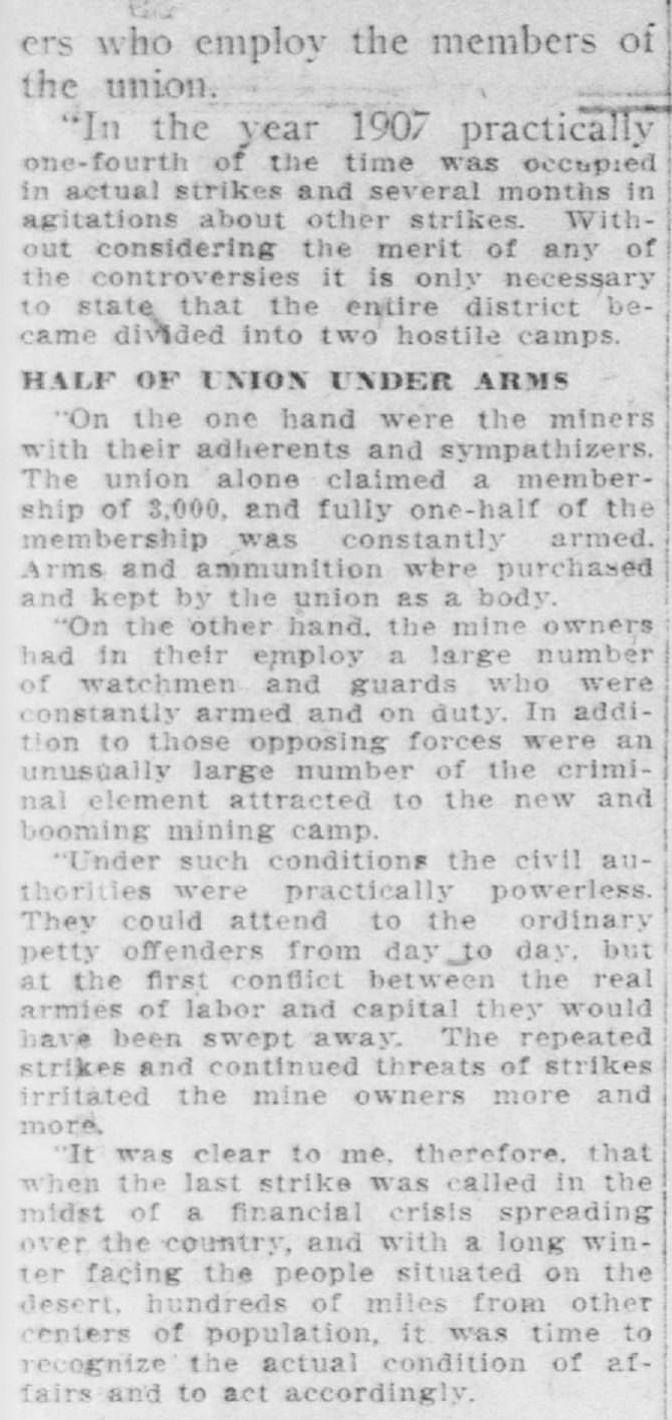
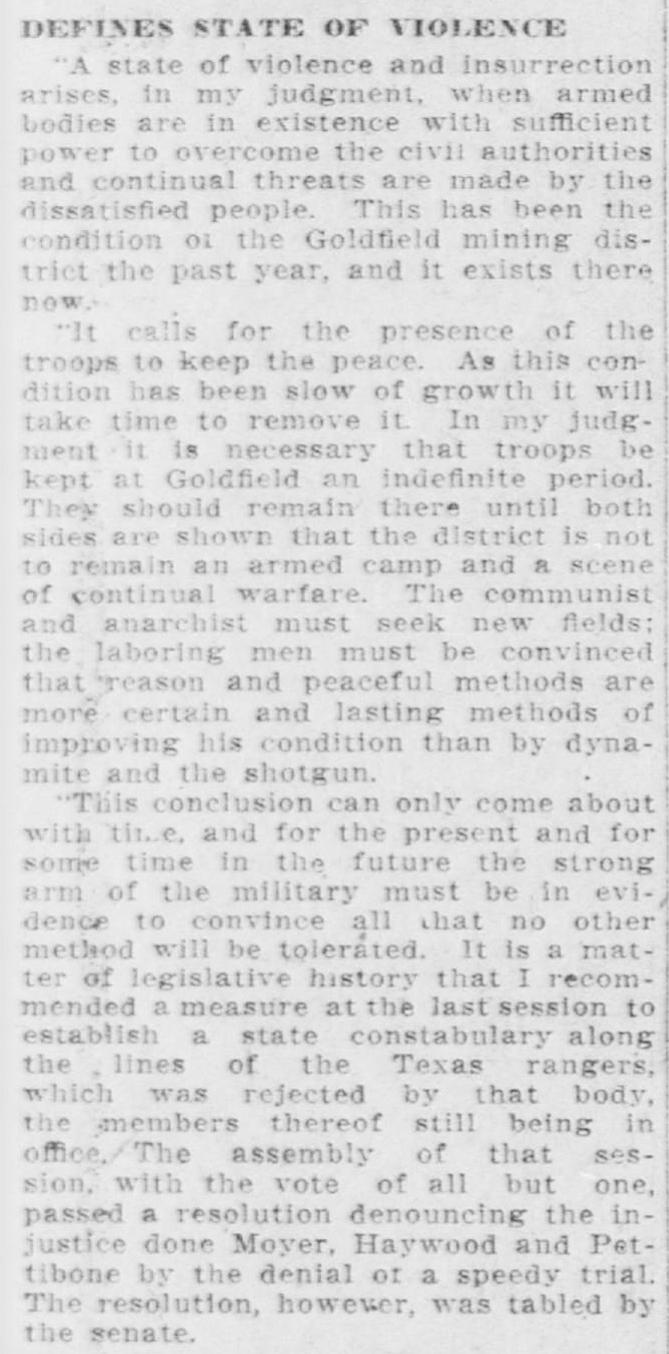
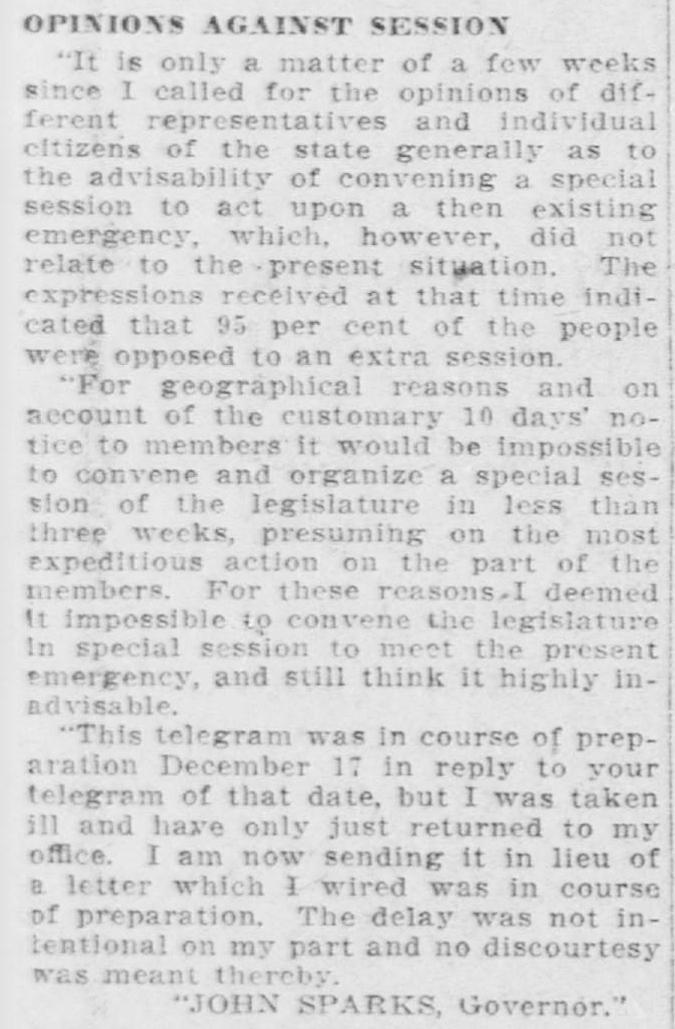
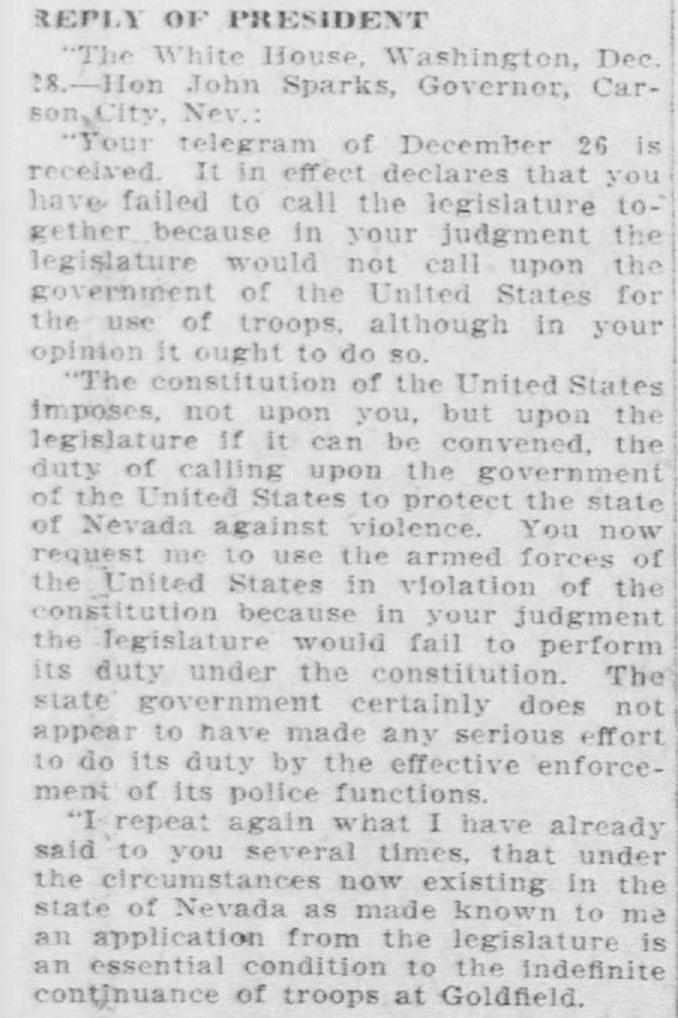
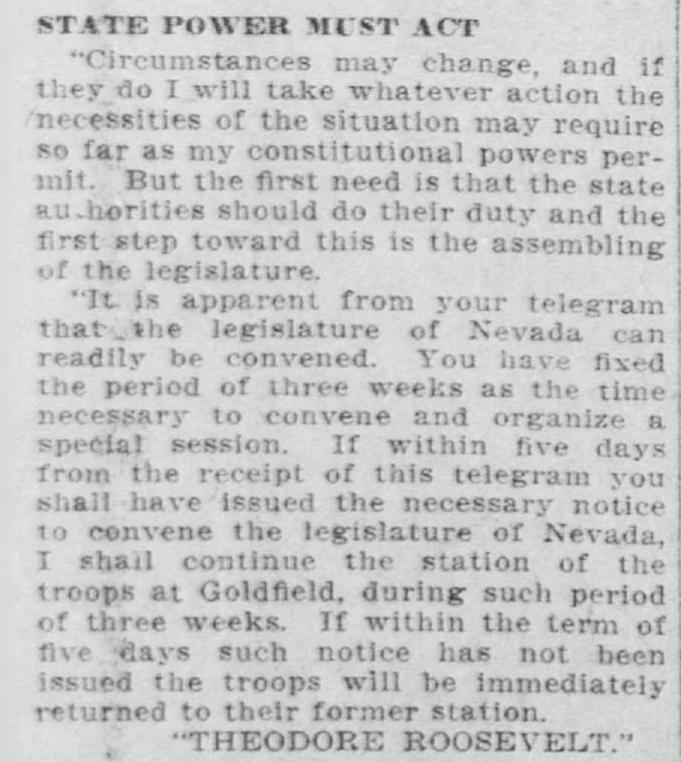
The San Francisco Call, Sunday, December 29, 1907
CDNC California Digital Newspaper Collection
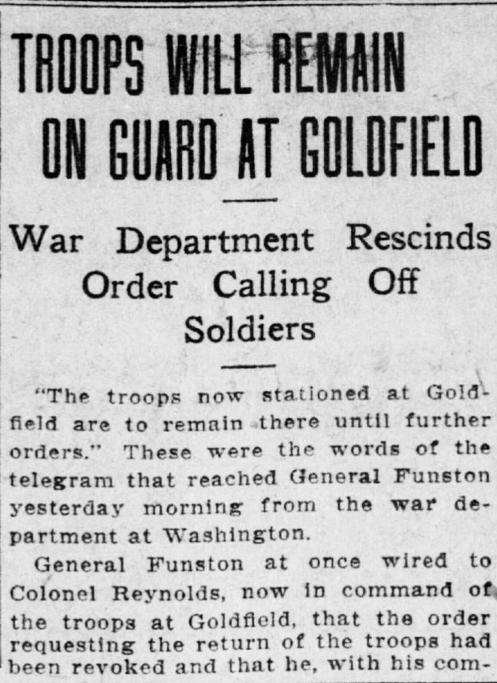
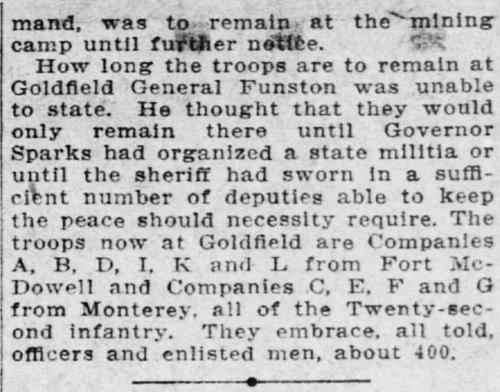
The above article is
from the San Francisco Call,
Sunday, December 29, 1907.
It illustrates that Funston had received word from Roosevelt,
rescinding the order to withdraw
the troops, and that order was relayed to Colonel Afred Reynolds,
commanding the 22nd Infantry at Goldfield.
CDNC California Digital Newspaper Collection
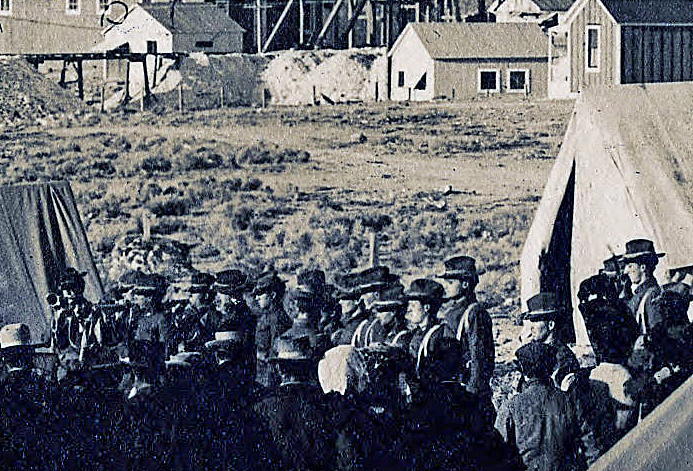
22nd Infantry Soldiers at their camp at
Goldfield, December 8, 1907.
At the left of the photo are three or four buglers, possibly
providing entertainment for the civilians
who are milling around.
Photo from the University of Nevada, Las Vegas Libraries
While Governor Sparks began the
process of convening the State Legislature, the Sheriff of
Goldfield
increased his amount of deputies, until he had amassed a force of
some 100 men. As a result of both events,
the 22nd Infantry began leaving Goldfield on January 3, 1908. The
website editor can not account for the changing
totals, of the number of Soldiers from the 22nd as reported by
the newspapers during this time.
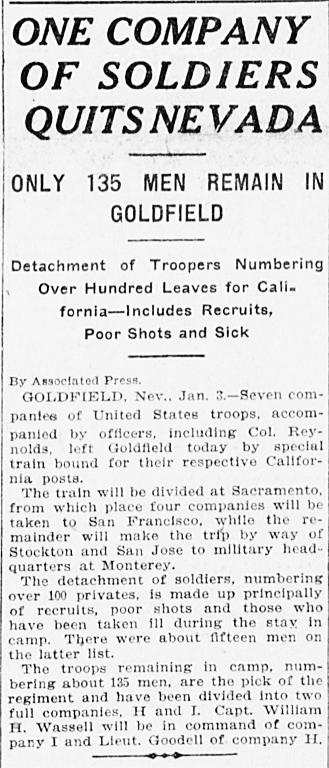
The above article from the Los
Angeles Herald, January 4, 1908,
announces the beginning departure of the 22nd Infantry from
Goldfield.
CDNC California Digital Newspaper Collection
Being the senior officer
remaining at Goldfield, Captain William Hudspeth Wassell
assumed command of all 22nd Infantry forces left there.
|
Article from The
Pittsburgh Press,
|
By March 7, 1908, Nevada had
created a State Police force, and together with the Sheriff's
force
in Goldfield, enough law enforcement presence was established in
Goldfield, so that the remaining
elements of the 22nd Infantry could be returned to their duty
stations in California.
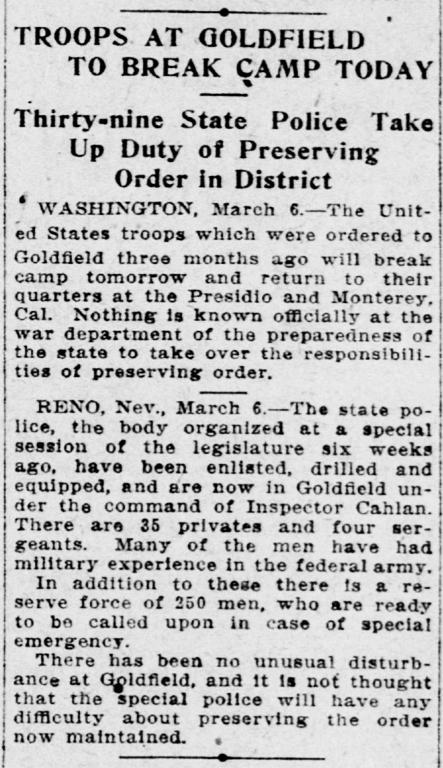
The above article from the
San Francisco Call, Saturday, March 7,
1908,
announced the impending departure of the remainder of the 22nd
Infantry from Goldfield.
CDNC California Digital Newspaper Collection
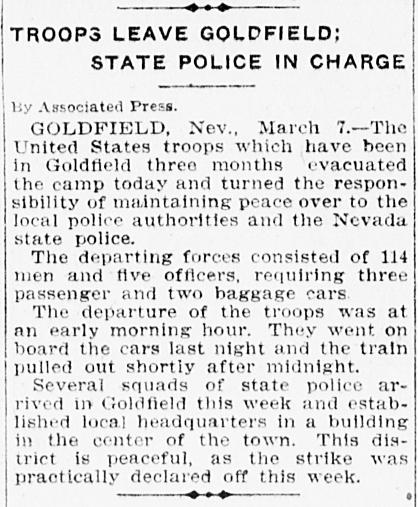
The above article from the Los
Angeles Herald, Sunday, March 8, 1908,
reported that the 22nd Infantry had completely left Goldfield.
CDNC California Digital Newspaper Collection
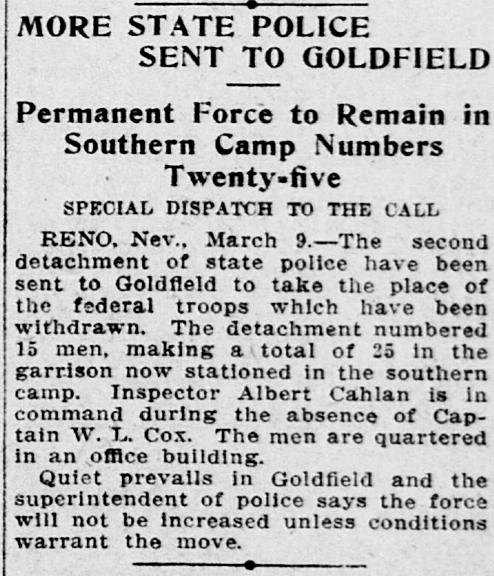
The above article from the San
Francisco Call, Tuesday, March 10, 1908,
reported that the Nevada State Police had replaced the 22nd
Infantry, and was now enforcing the law in Goldfield.
CDNC California Digital Newspaper Collection
An extremely tragic consequence
of the 22nd Infantry's duties in Goldfield, was the illness
suffered
by Captain William H. Wassel, who had been left in command of the
two companies which remained
at Goldfield until March of 1908.
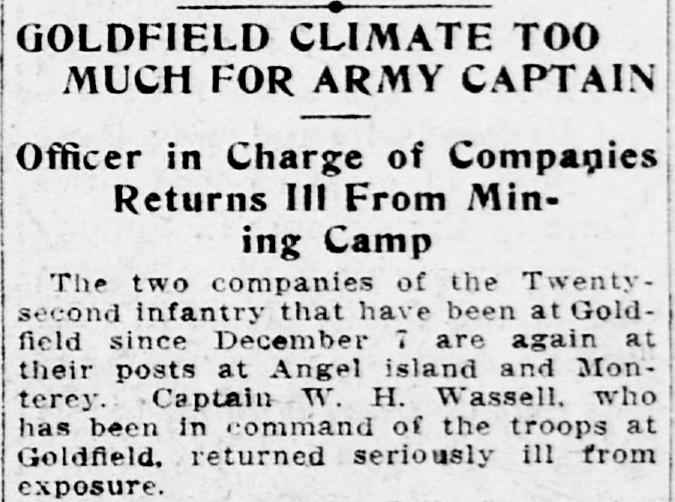
The above article from the San
Francisco Call, Tuesday, March 10, 1908,
announced the return of the final contingent of Soldiers of the
22nd Infantry from Goldfield,
and mentioned the illness suffered by Captain Wassell.
The Regimental History of 1922
states that CPT William Wassell became ill as a result of
exposure to the elements
during the harsh winter of December 1907 and January 1908 at
Goldfield. Upon his return to California, he was hospitalized
at the base hospital at the Presidio. Wassell never recovered
from his illness, and, later having been diagnosed with
tuberculosis,
was transferred to the General Hospital at Fort Bayard, New
Mexico, where, on April 3, 1908 he died from complications
resulting from the disease.
Wassell graduated from the US
Military Academy in 1887, and joined the 22nd Infantry at Fort
Keogh, Montana,
in 1891. He was wounded in Cuba while sharing command of Company
D, had served throughout the campaigns
of the 22nd Infantry in the Philippines, and had co-authored the
first official history of the Regiment.
Home | Photos | Battles & History | Current |
Rosters & Reports | Medal of Honor | Killed
in Action |
Personnel Locator | Commanders | Station
List | Campaigns |
Honors | Insignia & Memorabilia | 4-42
Artillery | Taps |
What's New | Editorial | Links |